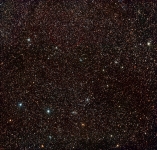Cassiopeia as you will know is open cluster central – but do you know that there is a region THICK with open clusters (6 of them) AND it has a fantastic supernova remnant as well? Use your scope’s GOTO to go to NGC7790 or NGC7788 in Cassiopeia – get a decent field of view – and take a very long total exposure with long subs – you won’t regret it.
This special area was first brought to my attention by Eddie Guscott in his Practical Astronomer magazine [August 2008, pages 22-24] in a great little article called “Six little clusters, all in a row….” The six little clusters comprise King 12, Harvard 21, Frolov 1, NGC7788, NGC7789 and Berkely 58 moving from north to south through this region. It wasn’t however the “Six little clusters, all in a row” that caught my attention in the black and white image on page 23, what was that amazing object just making an appearance at the top of the page?? There was a semi-circular region of nebulosity, obviously part of a great circle of nebulosity – but what was it? A little detective work showed that this was CTB1, a beautiful supernova remnant, brilliantly imaged by Steve Cannistra – I wanted this one!! No problem – I have the Hyperstar – I can image ANYTHING – especially faint stuff, not actually true. Even though I took very long sub exposures, and extremely long total exposures – I just couldn’t pull out CTB1 – even with Noel’s superb processing skills. Why? Because this one is getting close to my skyglow limiting background. O.K. no problem – stick in an H-alpha filter and have another go. Yes I did this, and found the problem with narrowband filters and low f# optical systems – they don’t go together! O.K. no problem again – just get one of those wideband H-alpha filters and go for it again. Well yes but the huge increase in bandwidth means you sacrifice a lot of contrast – and to be honest, you don’t actually gain a lot by going down this route with the Hyperstar system. So what is to be done? The only answer I have is to one day put the f#4.5 Sky 90 back on with a narrowband H-alpha filter and do the thing properly, but that may be a LONG time off. Until then, just look at this rich region of open clusters – and better still – get imaging them.
The accompanying image is a mosaic of 3 Hyperstar III/SXVF-M25C frames and measures something like 3.5 x 24 degrees. Sub-exposure times with the Hyperstar III went to over 10-minutes (!!!!) equivalent to over an hour with the Sky 90 – and total imaging time would be in excess of 20-hours. One of my more impressive deep-sky imaging failures. Why not see if you can do better and grab a really nice image of the little-known and rarely-imaged CTB1?
Until October – clear skies and happy imaging!!!



I may well have a go when the moon goes away – I was pondering what to use as a challanging faint Ha object, and this sounds fun.
Current FOV is 3deg41′ by 2deg48min so lots of framing choices to make with all those other regions of nebulosity and clusters all over the place. I guess I will just suck it and see when I get there!
Best of luck Tom – it really is VERY faint – and for me, not a lot of fun with all those hours spent for so little return on CTB1 itself. Got a nice image of the clusters and the Milky Way background though 🙂
maybe we both takes lots of frames and then stack both lots together 🙂
Shooting it now with the Ha filter.. I can confirm your observation about it being chuffing faint…
Now that is a very good idea! Yep – I think it’s likely to be near our skyglow limit.